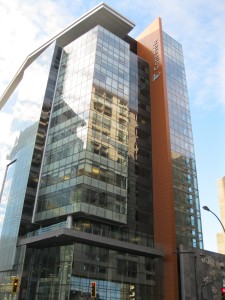 Concordia University’s LEED Certified John Molson School of Business building. Image source: magazine.condordia.ca
Concordia University’s LEED Certified John Molson School of Business building. Image source: magazine.condordia.ca
Doug Sharpe
President of Elasto Proxy
Did you know that buildings require 40% of the energy that’s consumed by the European Union (EU)? According to the National Institute of Building Sciences (NIBS), buildings in the United States are also major energy consumers, especially of fossil fuels. As businesses, homeowners, and governments seek to contain energy costs and demonstrate a commitment to the environment, architects and engineers are joining builders and construction companies in learning about zero-energy building (ZEB).
What Is a Net Zero Energy Building?
A net zero energy building (NZEB) produces as much energy as it consumes over the course of a year. This definition seems simple enough, but there’s room for disagreement over specifics and metrics. Can true NZEBs be connected to the grid? Should zero energy buildings have zero carbon emissions and use only renewable resources? Designers have complained that a canvas tent with a solar panel could be an NZEB, but a new Net Zero Energy Building Certification provides some guidelines.
For our purposes, let’s use a basic NZEB definition from the U.S. Department of Energy’s (DOE) National Renewable Energy Laboratory (NREL). “A net zero energy building,” explains an NREL publication, “is a residential or commercial building with greatly reduced energy needs through efficiency gains such that the balance of energy needs can be supplied with renewable technologies.” NZEBs can feature net zero site energy, net zero source energy, net zero energy costs, and/or net zero energy emissions.
Real-World Examples
Net zero building projects may sound futuristic, but there are residential, industrial and commercial structures that meet our definition. Examples include the Adam Joseph Lewis Center for Environmental Studies at Oberlin College in Ohio, and Phase 1 of NREL’s 220,000 sq. ft. Research and Support Facility (RSF) in Golden, Colorado. The California headquarters of the David and Lucile Packard Foundation was also designed to be a zero energy building or ZEB.
What do these green buildings have in common? In each case, on-site electricity production from renewable resources is coupled with energy-efficient lighting, heating, and appliances. Both the Adam Joseph Lewis Center and the Packard Foundation headquarters generate enough electricity to sell power back to the grid. The NREL’s Colorado facility uses solar power, too, but meets some of its energy needs with advanced heat recovery technologies that were developed there.
The Sky’s the Limit
Are sustainable skyscrapers on the horizon? Nashville, Tennessee is best-known as the home of the Grand Old Opry, but one architectural firm is planning to put the country music capital on the map with one of the world’s most energy efficient skyscrapers. The 605-ft. tall building, designed by Adrian Smith and Gordon Gill Architecture, will capture “solar heat” from outdoor air in the summer and warmer air from within the building during the winter months.
Additional energy-saving features will include integrated solar panels, under-floor air distribution, and a shiny “double-skin façade” that promotes energy efficiency. The mixed-use building will house a 200-unit, five-star hotel and two-story conference center along with a restaurant, health spa, pool, and business center. Sounds like a great place for a conference about green power or green construction!
Building and Construction Products
As builders pore over blueprints for zero-energy facilities, buyers will need to acquire more than just power generation and electrical distribution systems. As an experienced supplier of specialized seals and insulation for the green power and construction industries, Elasto Proxy is ready to strengthen supply chains. How can we help you?
For over 20 years, Elasto Proxy’s technical designers and custom fabrication specialists have helped quality-conscious partners find sealing solutions for lighting fixtures, rooftop HVACs and hatch covers, and windows, doors, and skylights. Our solutions providers have also supplied windmill seals and rubber gaskets, sounds insulation for power generations, and protective profiles for PV panels.
Is your business ready to benefit from a potential net zero energy building boom? I hope you’ll comment on this blog entry, and connect with me on LinkedIn.









